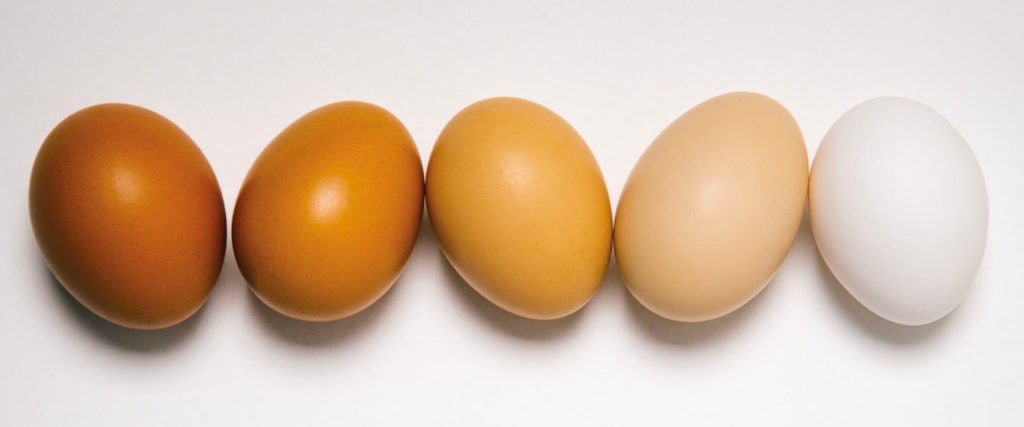The first time I saw a brown egg at a grocery store, I’m certain that I asked my mother if it was laid by a brown chicken. Yeah, I know — that sounds problematic. But in my defense, even my young mind had deduced by that point that the skin shades of human parents were a factor in the shading of their children. So, I thought, Why not with eggs, too?
Admittedly, all these years later, it still sounds stupid. But it does beg the question: What is the actual difference between brown eggs and white eggs — and are those differences any more than shell deep?
So what gives? Why is my egg brown?
The funny thing is, even as a child of alarmingly low intellect, I had the story partly correct. It turns out that the breed of the hen at the origin of the egg ultimately determines the color of the egg that is produced. So if an egg is naturally white and you found it at a garden-variety grocery store, it was probably laid by a Leghorn chicken. If an egg was laid by a chicken who isn’t one of Foghorn’s relatives, that egg is probably going to be of a shade other than white.
For example, Orpington and Marans chickens are the most common depositors of brown eggs. And several types of chickens — including Cream Legbars and Araucanas — lay the sort of blue eggs you would expect a Smurf or a Na’vi to pop out of.
Things get even wackier once you learn about the effects of crossbreeding chickens. When an Americaucana’s egg is fertilized by a Marans rooster, the result is an “Olive Egger,” a Frankenstein’s monster of a chicken that produces olive-green eggs.
Interestingly enough, all chicken eggs start out lily white inside of the hen. The pigmentation is only added to the shell as the egg passes through the hen’s oviduct. That’s where the magic happens, as a pigmentation procedure is executed with Easter-egg-caliber dyeing results. However, the variance in egg color — whether it’s white, brown, blue, green or speckled — is a direct result of the different compounds at play within the bodies of each chicken. Chickens that lay blue eggs incorporate biliverdin or oocyanin into the pigmentation of their eggs. Brown eggs are generated by the presence of a similar compound called protoporphyrin.
Then why are most grocery-store eggs white?
Does this mean the common, lily-white eggs that most of us purchase at the grocery store have been bleached, tampered with or adulterated to create homogeneous, nutrient-stripped balls of chicken embryo? The simplest answer is that the overwhelming majority of egg-laying chickens in the U.S. are White Leghorn chickens, which produce white eggs. They’re also the most efficient mass-producers of eggs, having the unmatched ability to deliver the highest return on a farmer’s investment when it comes to the chicken-feed-to-egg ratio.
Well, if an egg is a color other than white, it’s better, right?
Martin Luther King Jr. would have been happy to know that the exterior color of the egg actually has nothing to do with the quality or caliber of the egg contained therein. There is nothing inherent in the process of popping a brown egg, or an egg of any other shade, out of a hen’s cloaca, that manifests in a discernible nutritional difference.
But I swear that brown eggs taste better than white eggs!
You’re saying this because you ran one egg short while preparing this morning’s egg-heavy breakfast, and you stole a white egg from your roommate’s side of the fridge, right? Now you’re wondering if you’ve inadvertently poisoned yourself because you consumed a run-of-the-mill, unfertilized embryo that was insipid and lifeless in comparison to the innate burst of inspirational flavor brought to you by the color brown.
That may be true, but there are other factors at play here, too. While brown eggs don’t naturally taste different from white eggs, there is an elevated likelihood that the brown egg you smashed into your homemade eggnog came from a chicken raised very differently from the one who popped out the white egg for your Greek omelet.
Egg-laying hens can be raised in vastly opposed environments, and fed wholly different diets. Specifically, factory-fed chickens may be injected with hormones and fed a constant diet of chicken feed and soybean meal, while pasture-raised hens are free to munch on grass, worms and other morsels that are freely available in a traditional farming environment. It’s frequently the dissimilarities in these diets that produce the variations in the makeup of the eggs, and the coloring of their yolks. That said, studies have shown that these nutritional differences aren’t statistically significant.
So what you’re saying is…
… that while the brown eggs you scored from your local co-op market might have an enhanced essence of egginess when compared to the white eggs from your chain supermarket, the flavor variance is due to the way the chickens who laid those eggs were raised, and not to the differences in shell color.
Now that we’ve cleared that up, let’s talk about the way you were raised so that you’ll know better than to steal your roommate’s egg next time… thief.

